Hundreds of websites are indexed in search engines every single day. No doubt, the accurate optimization of a website has become its necessity to survive. But with the constant evolution of SEO, it is not easy to stay on the right track. More than often, even the top marketers make the biggest SEO mistakes.
Reason?
Well, there are many. Like, most people work on their optimizing strategy without precise understanding. Implementing SEO is of no use if you can’t distinguish between good and bad SEO techniques. And, that’s why many end up with disappointing results.
To get you on the right track, here is a list of SEO mistakes to avoid at all costs. Also included – facts, studies, tools and real examples for your proper guidance.
1. Not Investing in Fast Site
No matter how good the content or structure is, if your site isn’t loaded on time – these are worthless. Your faster competitors are just a single click away. As a result, visitors bounce back from your website. Speed is the first impression of your website. Clearly, if you’re not investing in a fast site, you are losing clicks every second.
A study by Moz, concluded that a site loading in 2.9 seconds is 50% faster than the other websites. Is your website one of them?
How Does It Affect Your Ranking?
According to Google, if your website takes more than five seconds to load – it’s too slow for the users. Such sites give a bad user experience and hence, you get less SEO score. Even the Google search console has started showing speed insights now. So, clearly it is very crucial for SEO. All and all, having a slow website means a high bounce rate, and thus, a low number of visitors and conversions.
But How To Measure it?
Here’s where you can test the speed: Google Speed Insight. Simply enter the URL of your website and you get it analyzed for both – mobile and desktop loading time.
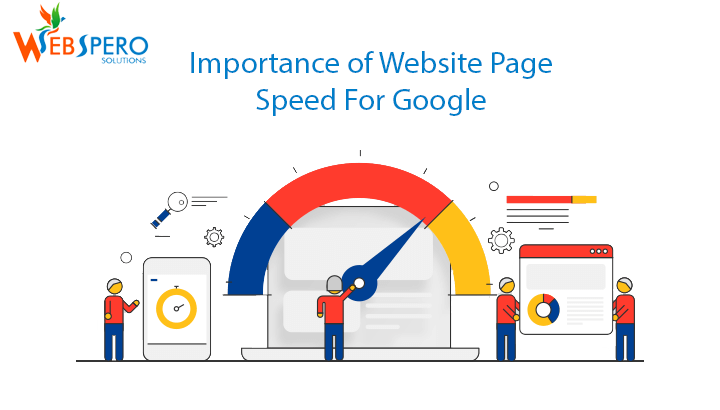
Do the needed changes shown in the analysis report and improve your website loading time. Also, you can learn more about page speed factors and how to improve it by using PageSpeed Insights Tool.
2. Not Focusing on the Website’s Structure
Inaccurate website structure makes crawlers confused. Consequently, they give a red flag to search engines and thus, you are never able to get the desired rank position.
The structure of your website reveals a lot to Google. Like,
- First, it makes the search engine understand what your website is about.
- Second, where the most important content is present on the site.
- Third, it highlights the website pages which are important to us .
All these factors make it easy for crawlers to give a green flag to search engines. So, a good website structure always matters in SEO.
Make it According to Your Niche!
Go for a Cluster or Pillar structure for a service-oriented or blogging website and Silo structure for e-commerce sites. Cluster strategy restructure your site to develop your topical authority. By topical we mean the key -topics. Basically, it’s about moulding your website architecture by first establishing credibility around main topics and then building out subtopics within each of your main groups. Here is a graph by hubspot, showing how to develop such structure.
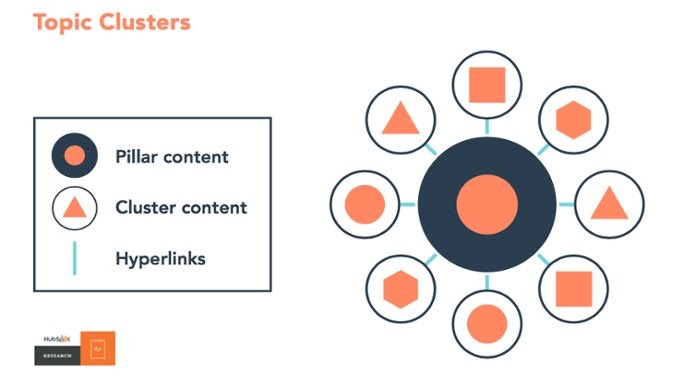
Source:- https://blog.hubspot.com/
The big circles are your pillar content – the main key topics. The smaller ones are the sub-topics that work as supplement content for your pillar content.
The silo structure is all about categorizing the content hierarchically. Keeping the main topic on top, and dependent topics as the branches. Practically, you pick out the main products & services pages and then group and organize them with related content via crosslinking. Linkedin even offers a course for it.
3. Using Low Quality or Duplicate Content
Beginners to SEO go for quantity over quality. Some of them even prefer spinned content. Although they get it well optimized, yet it decreases the value of your website. You need to understand one thing – visitors are humans, not bots. They can judge your content. Think about the impression it’ll give to your visitors. Consequently, you’ll lose their trust. . Moreover, Google can easily recognize duplicate or spinned content. Google has become great at it after the rankbrain algorithm update. Here are some examples of low-quality content.
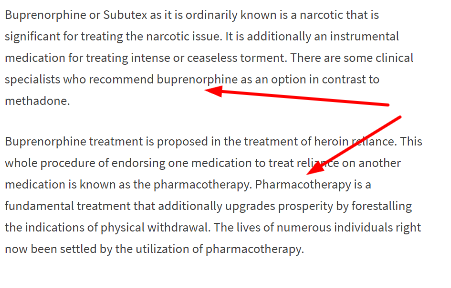
Remember, if the visitors don’t like to read the content, so will the crawlers. A study by AHREFs shows that only 5.7% of 1.8 million new pages get ranked in Google’s top 10 search results. Is your content good enough to beat those 5.7%?
Thinking What To Do?
All the SEO writing techniques revolve around high-quality content. None of it prefers quantity over quality. Good quality means original content that gives value to the reader. Use a generic tone in which you are addressing your reader. Curation is fine but duplicate (copy-paste) content is a strict no-no. When curating, ensure that you are giving credit to the original sources.
There are standard guidelines for every content piece. Like, Read Flesch Ease score, percentage of passive voice, word limits and few more. Your writer must respect these guidelines. However, use Flesh Ease score for reference but don’t die on it. Just read your content and analyze if it is easy to read. If it’s a long content, use bucket brigade words to make it interesting. Also, content is not just about text, make use of other variants too. Like, images, infographics, and even videos.
If you’re giving information, employ the rule of 5 W’s. That is, include WHY, WHEN, WHERE, and WHO in terms of the context. All and all, go for high-quality, informative, original content which is inclusive of different media formats and bucket brigades.
4. Poor Internal Linking
Unnatural internal linking patterns don’t give the right link value to the pages. Any outlandish link is generally classified as a fraudulent practice by search engines. Google has sent out such warnings many times.
Every website has some link juice which is divided into different web pages via internal linking. According to LinkedIn marketing trends 2022, you can add value to the pages with interlinking. Let us understand with an example, two websites each having four microblogs. First one has internal linking among its blogs, but the second has no internal links. Definitely, the first one will rank faster than the latter in any search engine.
When doing internal linking, link the high link value pages to less performing pages. But make sure not to place links without relevance.
For Example,
Suppose, you have three articles on your site. One is written on “dog food”, the second one is on “cat food” and the third article talks about “pet food”. Clearly, “pet food” is relevant to both “dog food” and “cat food” , so it can be interlinked to both. But you can not interlink “dog food” with “cat food” – even though they have food in common.
According to MOZ experts, your latest blog posts get more link value if they get a link from the home page. The homepage of your website has the most backlinks and thus it has the greatest link value. Therefore, search engines will find new posts quicker if they’re linked to from the homepage. You can read more about this – here. Also, avoid too much internal linking.
Having that said, it is also vital to not overdo internal linking. We have explained it precisely in the next point.
5. Focusing Too Much on Internal Linking
Too much interlinking makes a website spammy. This is one of the common internal linking mistakes that most marketers make. There should be a reasonable number of internal links on a webpage. Many experts recommend only upto 100 internal links per page otherwise it dilutes the page’s link equity. However, it also depends upon the content limit , SEO authority and many other things. Here’s a brief idea on it by Moz forums.
Apart from this, many commit the sin of overlinking to the homepage and forgetting the deep internal pages. A healthy internal linking profile has links pointing to both in ratio 1:1. That is the 50% of the links pointing to deep internal links and rest to the homepage or other top navigational pages.
Wait, there’s one thing more!
Don’t use the same anchor text for every link. Do not over-optimize them with keywords. Previously, using the same keyword in anchor texts might have helped your website to rank higher for that keyword. But today, the search engines want the anchor text to say more about the linked content. So, don’t add the exact same keywords to every link’s anchor text. Instead, use phrases that describe what the target link is about.
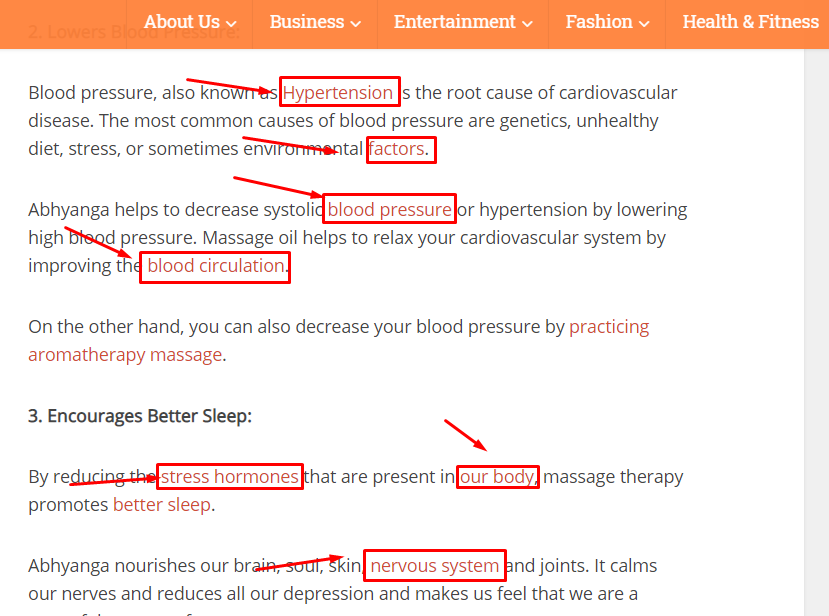
6. Disregarding Analytics
Once the website is cached and ranked, many often disregard analytics. No doubt, that the goal of SEO is to get traffic on your website. But that’s just not it. Real ROI comes from conversion. To understand the fundamentals of conversion, you need analytics. Let us explain it to you.
Conversion depends on traffic, and traffic is dependent on evaluating your web pages and implying the needed strategies. Google analytics shows conversions and highest valued pages. Then using the search console you can see the top keywords driving traffic to those pages, thus understanding your most important and productive keywords. Moreover, you get to know about the web pages with high bounce rates.
Knowing all these, you can plan which pages need what necessary changes. Accordingly, you can set goals to get the most ROI.
7. Not Using Right Keywords
The whole purpose of the SEO is to rank for specific keywords. But which keywords in particular? Most optimizers fall in the trap of choosing the wrong keywords, which may seem right. However, for fruitful optimization, avoid using these keywords for your site:
Generic Keywords: These are mainly informative keyphrases that attract visitors who are just eager to get the information but are not prospective customers. They might bring you much traffic but with a reduced conversion rate. Here’s an example:
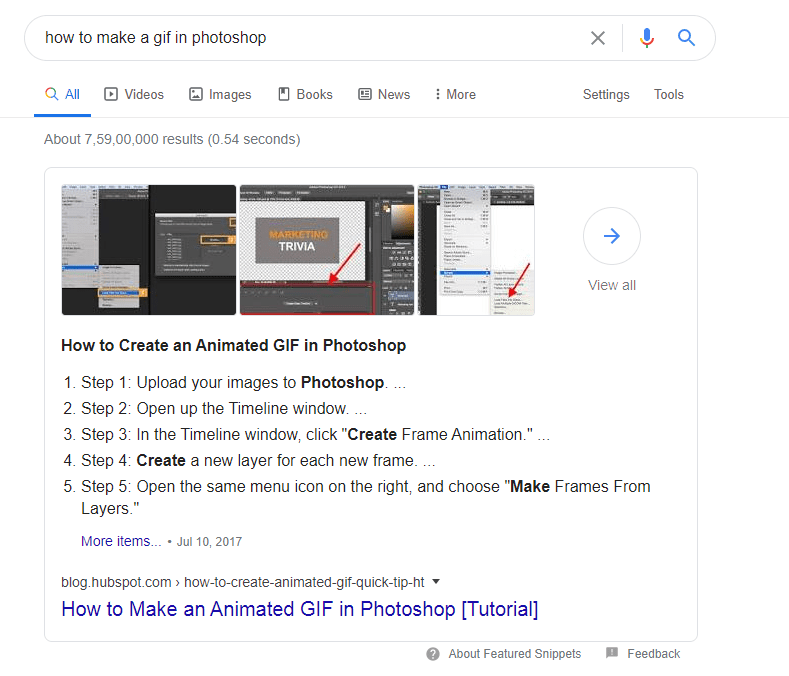
In this example, we can see that the Hubspot is ranking for a very generic keyphrase – “How to make a gif in Photoshop”. No doubt, they are getting tons of traffic from this keyword. However, do you think that a person who is trying to create a gif, will purchase a Hubspot CRM solution? Of course not!
But, since Hubspot has deep pockets, they can afford non converting traffic. And they can work on probably a hundred similar generic keywords, but we can’t. So, choose your keywords that have chances to get you customers, not just the traffic.
One or Two Word Keywords: They are highly competitive and we often don’t have that much authority to get it ranked for our site. Moreover, buying intent for those keywords is relatively low. For example, People searching for “Shoes” have less purchasing intent. But people looking for “Nike Airmax 90 Shoes” definitely wish to purchase it .
That is why, most experts may agree on using specific long tail keywords. They specify your services and get you more qualified traffic. Even if their search volume is less, their intent gets you conversion. A study by Wordstream, revealed that 50% of online purchases happen from long keywords. So, they are easy to rank for and definitely increase your sales.
But, How to Choose The Right Ones?
The correct approach is to use the phrases according to your target audience. It’s imperative to understand what words your audience utilize while searching for the services of your niche. Think as per your client’s perspective.
Make use of different tools like Keyword Planner by Google or SEMrush. These tools are adequate to find trending specific keywords as per your niche. People skip spending much time on keyword research and end up wasting their effort and money. Obviously, you don’t want to be the one, do you?
8. Keyword Stuffing
So, you got the right keywords with the above tip, but how to correctly use them in your content?
For those who believe using target keywords in every third line can boost their ranking, this strategy is painful for your site. Even you can get your site penalized by the search engine. Yes, overstuffing keywords in the content is taken as spam by Google and other search engines. Why? Because overusing your keywords, make your content unnatural for the audience.
Looking For Content Tips?
Well, there’s only one: don’t write content thinking it for SEO; instead, write it thinking of your target audience. Don’t write content marketing pieces as to cram keyphrases; they become less valuable that way. Having the right keyword density is important. Keyword density is how many times you have used your exact keyword in the content. The best tactic is to forget about keyword density, and only use keywords where it makes sense. If you start writing content with keywords in mind, it will naturally fit in appropriate places.
Usually, the thumb rule is to think about what the audience is looking for and compare how much value your content is giving to them. Always try to write naturally, and don’t forget to consider the reader’s experience. You can break the monotony by using some long-tail variations and synonyms for the keywords. They better match with the audience queries and bring more traffic.
9. Using Duplicate Meta
SEO guidelines say to avoid duplicate metas at all costs. Although, it may not get your site penalised by Google, but can surely cost you rankings. In fact, Mat Cutts of Google, once said in a video that it’s better to leave meta descriptions blank rather than duplicate them.
Search engines pick up a meta tag only once. That means only one page of your content is being referenced. Therefore, if you have multiple pages with the same meta on your site, those pages will never be indexed. Instead, all of those pages of content are actually diluting your SEO efforts. Because they are competing with each other. This is confusing for search engines. For them it’s like having different pages on your website that are about the same thing.
Consequently, your ranking falls and even if you get your one webpage in SERPs, visitors will be deprived of the useful content on the page that was not shown in results. And, who knows, maybe the visitor was looking for exactly that information.
So, you must remove all the duplicate metas from your site. For this, you have three options.
- Change the title of pages with duplicate meta.
- Use a Canonical URL to specify which page Google should index.
- Set all to noindex except for the one which you think is the most relevant.
For Duplicate Meta Descriptions, Do This:
Open the Titles & Metas settings on the Yoast SEO, enter a fixed text with %%page%% at the end of it. Adding this template tag will solve the problem of duplicate pagination or multiple paginated pages.
Remember the correct use of Meta-tags is really important for good SEO of your site. That’s why you must avoid duplicate metas at any cost. Whether it’s Meta descriptions or titles, all of them should be fixed for better user experience and performance of your website.
10. Neglecting Search Console
Neglecting the search console is like ignoring significant data that promises to be extremely useful for SEO. With the search console, you can be aware of every detail that can get your site higher rankings in SERPs.
How?
It monitors your Google ranks, impressions, CTR, and updates you if something goes wrong with the indexing of your site. Moreover, it gives your performance report, which keywords are ranking, and what are their average positions. Clearly, if you won’t use it, you would never know what’s working and what’s not.
Apart from this, the search console shows all the errors that Google finds on the website that you can fix. Like structured data issues, page speed issues, 404 errors, and also the crawling errors. So, start using Google search console today to find broken links, your CTR, and position on SERPs and then make the needed changes to make your site perform better in SEO.
11. Ignoring Mobile Site
Another most common SEO mistake is to focus only on the desktop site and ignoring the optimizing site for the mobile. Look around you, from elders to kids – all have a mobile device of one flavor or another. Aren’t these people your target audience?
If Yes, Then What Are You Doing About it?
Today, Google does mobile-first indexing; your mobile website will decide where you rank, so work on making your site mobile friendly. Cover these points in this regard:
- Work on making your site mobile -friendly using responsive design.
- Make sure the structure is sound.
- Focus on the UI.
- Ensure that all the essential content should be available on your mobile site as well.
Remember, mobile devices are the most preferred way of your audience to access content online. And without a robust mobile site, you will lose rankings even if the desktop site is great.
12. Neglecting Bounce Rates
One of the most underestimated metrics of SEO is the “Bounce rate.” Wondering what it stands for? A bounce is a single-page session on your site. In Analytics, the bounce rate is calculated specifically as a session that triggers only a single request to the Analytics server, such as when a user opens a single page on your site and then exits without triggering any other requests to the Analytics server during that session
For instance, if the bounce rate is 90%, it merely means that 90 users out of 100 have left the website page without engaging or making any activity further. So typically, this happens when the user jumps back by clicking the back button.
How Does it Affect SEO Ranking?
When calculated precisely, high bounce rates merely means more profound errors and user experience issues like slow-loading pages, technical failures, low-quality content, improper links, and misleading title description. Google also focuses on the relevant metrics like CTR rate and time spent on page. So watch for these elements, they are something you need to understand and to improve upon. Otherwise, your website ranking will get devalued.
13. Not Building Quality Links / Building Spammy Links
Link building is the practice of building one-way backlinks to a website that gradually helps in improving search engine visibility. But it doesn’t mean you have to create tons of low-quality links. There’s a clear cut distinction between bad and good backlinks. The good ones are highly relevant to your business, whereas the bad ones are low-quality, sound spammy, and don’t show any relevance with your product/service.
Google is smart enough to understand the black and white description. So, it is always better to have an intelligent backlink strategy that can help you to build a diverse and organic link profile. In simple words, you have to earn it. However, if your website has too many spammy links, then remember sooner or later, Google will catch it, which can even ban your site or may pose you a hefty penalty.
How Can You Build Quality Links or Avoid Spammy Links?
Well, there are plenty of ways you can leverage the quality of your backlinks like writing competitive content, creating infographics, composing testimonials, linking externally, and taking advantage of public relations. Along with this, you can make other websites aware of the same by lining up social cues. Ultimately, all these to-dos revolve around only one factor and, i.e., building quality links by building quality relationships.
And as John Mueller said, “On the first hand manually we try to take action where we think it’s needed, and on the other hand algorithmically we try to neglect aspects that we can kind of isolate.” From this, he meant that if you are building low-quality links, you might not be penalized. But such slacky links will be isolated over time, and won’t make any difference. Lastly, you won’t be knowing that, and might keep wasting time.
If you need help with link building, get in touch with us for high-quality link-building services.
14. Not Optimizing The Crawl Budget. {letting thin pages, useless pages crawl}
We can present all the crucial points that are mandatory for successful SEO. But what if we don’t optimize the crawl budget? The crawlers and bots will never find your excellent content. Generally, the crawl budget is the total number of requests made by the Googlebot towards your website to present the fresh content. Plus, if your site has a lot of pages, then you need to focus on prioritizing the pages that Google crawls. Well, is that enough? No, there’s a lot more!
Simultaneously, make sure to block the content that you don’t want to show up – like the duplicated content, dynamically generated URLs, and under construction website areas. Along with this, make sure to find and fix HTTP errors like 503 or 404 pages. Further, keep your XML sitemaps should be often updated and free from claptrap like non-canonical pages, 4xx pages, redirecting URLs, and indexing blocked pages. And yes, don’t forget to take care of your website structure and internal linking.
15. Ignoring Local SEO
For most of us, Local SEO might be the character of the month, and the very next we might have overlooked it. Wondering how that makes a difference or is it that relevant? Definitely, YES! Key statistics by Hubspot have shown that 50% of the smartphone (34% of the tablet) users visit a local business every 24 hours. So if your company hasn’t invested in local SEO techniques, then you need to know that consumers won’t find your business.
If you are still not convinced, then here are a few things that can happen if you ignore local SEO. Let’s have a look:
- Online listings can commonly dilute your online presence and have a severe impact on the SEO ranking if they are inaccurate.
- The lower is the rank; the less will be the organic traffic for your website.
- Also, you’ll relatively miss out on the right spot on Google, and your competitors might take it.
- As a result, your competitors will get that considerable share of organic traffic – and gradually better business. Your online presence will weaken over time, and your business could suffer from inaccurate listings.
So How Can You Keep Track of it?
First of all, you need to take advantage of popular directories that can list your business online with all the necessary details. Then, create and optimize your Google My Business account. Not having a GMB profile is one of the noteworthy local SEO mistakes to avoid. With this, optimize your website with the Voice Search and a mobile-friendly version. Make sure to develop and update content based on local events and news.
Get testimonials or reviews submitted from your happy customers and focus on getting high-quality backlinks. And, don’t forget to create unique content for each page, when your business has multiple locations. In case you have a vast set of products and services with different geographical areas, utilize the location-based copy for every single page.
By implementing all the actions mentioned above, your business will not only take advantage of the local searches but will also hold a robust base, even if new SEO features are introduced on the further stages.
16. Not Creating Linkable Assets
You can’t merely build quality relevant links to your website unless you don’t have any of the linkable assets. Earlier, the process was much laxer, but nowadays, you need to create something worth linking to. Remember, if your website has no linkable assets, then it has nothing to offer them.
Generally, linkable assets can be the events, content, or anything else that seems interesting to the targeted audience or marketplace. What do they do? They strengthen your authority, expertise, and online brand presence. Also, they keep bringing relevant links to your website while generating useful leads and audiences. Overall, good linkable assets that raise your SEO ranking, organic website traffic, and social media perceptibility
How Can You Create Linkable Assets For Your Website?
Here, the key factor is to consider what the audience and customers have to say about your website. Know the frequently asked questions, and how can you solve them? And is there any way you can make better versions along with useful advice? As Eric Ward says that “Only useful content gets linked, the less worthy the content is, the less number of links you will receive.” Now, here “Useful” means it should be informational, helpful, and entertaining enough.
In the end, it doesn’t matter what industry you are classified in, start with creating meaningful linkable assets like Research Papers, Infographics, Case Studies, Definitive Guides, and Checklists. Otherwise, you will spend hours and hours on outreaching and promoting content without any results.
For example, here’s a sample infographic that we have created for our affiliate marketing blog:
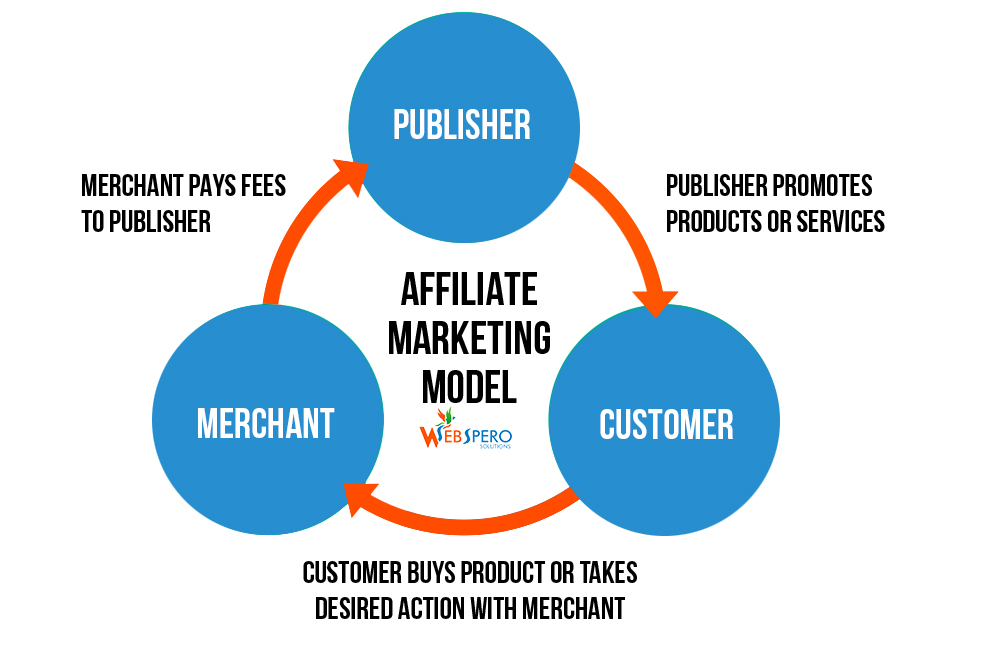
Although, the image is very simple but gives a clear message, and this image has got our website more than 20 backlinks, a link even from Hubspot.
17. Using Exact Anchors All The Time
Another most common mistake you can make is when you try to only focus on building quality backlinks. Well, we all know that anchor text matters! But mistakenly, we think that successful link building campaigns only include retrieving hundreds of backlinks “using the same anchor text.” And stuffing the most essential keywords into it.
But remember, even with the backlinks that have a lot of rich anchor texts, your rankings and website traffic will only drop! And there might be a time when Google might impose a penalty too.
So How Can You Create More Valuable Anchor Texts?
Instead of having that vital keyword in every anchor text, you should focus on mixing or rotating keywords more acceptably. Here’s a pro tip – Whenever you try to build backlinks for the next time, try to keep the ratio as 80% for the brand name in the anchor text, and 20% for anchor-rich texts. You can try multiple formats for your brand name like:
- Your website
- Yourwebsite
- Yourwebsite.com
- Your website.com
- www.yourwebsite.com.
Ultimately, with such assortments, you will be able to build quality backlinks while avoiding the silly mistake of using the same anchor texts.
18. Ignoring Link Velocity (building too many links in a small-time)
Link Velocity refers to the average speed of link growth for your web pages or website. However, retrieving a massive number of links at a higher velocity doesn’t guarantee that your website will surely rank well. Why?
Google and other search engines always evaluate backlink profiles and their growth over time. That is why it is essential to grab that only natural link patterns that contain informative and unique content. If such backlinks grow organically and efficiently, then likely Google will reward you with a good SEO ranking.
Besides, if there’s a sudden increase in the link velocity, then it indicates that your website is building links in bulk using bad SEO techniques. For example, if even 10-12 links are made in 3 months, then it seems natural. But if the count ranges around 100 or more than that within a week and then suddenly stops, then definitely it looks suspicious.
How Can You Overcome The Spammy Count?
As mentioned above, Google checks the link velocity, aka the rate at which your website receives more links. Adding too many backlinks at a faster pace may trigger a penalty to your website. So now, as you know that it really makes a difference to your SEO rank, you should better follow these tips:
- You can begin with curating better content than your competitors and promoting it steadily.
- Avoid too much and too fast link building.
- Building 5 to 10 inbound links in a month sounds natural, and only trust authoritative websites for it.
- You need to solidify your ON page game while ensuring that the OFF page is not being over-optimized.
- Certainly, be patient as the results usually take 3-6 months to show up.
19. Not Focusing on Brand Building
Not investing enough time in establishing your own brand/website is a huge mistake again. Google. As we all know that brand recognition is very much crucial for a solid and long-term marketing strategy. In simple words, if you know how to brand your products well, then you are simply making people more aware of your brand right when they are searching on Google or other search engines. Certainly, this helps your website to rank well.
For instance, if you enter the keyword “buy footwear” into the search bar, then more likely you will see Amazon or Etsy on the top. So it is not always about using keywords in your website name, there are other essentials as well. Conclusively, your SEO strategy revolves around them; only then the brand’s presence gets counted by the users.
So How Can You Build Your Brand Online?
Create compelling content and build quality links along with keeping SEO in mind, as it is the backbone of all your online efforts. Try to pick keywords that are highly related to your niche and tailor content for brand videos, promos, infographics, podcasts, and live events accordingly.
Also, be active in the community and increase word of mouth as much as you can. Run campaigns that people remember, and try to make your valuable customers your brand ambassadors as they bring more exposure to the brand/website.
Lastly, don’t forget to grasp the sheer edge of the social media world to leverage your brand’s presence. Here the social media platforms you can consider:
Facebook is the most used social network. However, you must know that today it is difficult to develop your community on Facebook without investing in a Facebook advertising campaign.
The advantages of Facebook
- The vast majority of your customers and prospects have a Facebook account;
- You can share all your content on Facebook: texts, images, and videos;
Youtube
YouTube is the leading social network for video sharing. Since video is THE marketing trend of today, YouTube must be integrated into your brand-building strategy according to your resources and skills.
The advantages of YouTube
- YouTube allows you to promote your image, your products, and services in the video;
- YouTube has a significant influence on your SEO;
- YouTube’s advertising network is one of the least expensive;
- 57% of consumers say that watching a product video increases their satisfaction and decreases their desire to return the product;
- 64% of website visitors who have watched a video stay on average 2 minutes longer;
- 64% of people who have seen a product/service video are more likely to buy;
LinkedIn is a professional social network, the market leader. The posts made here differ in this respect from what you can find on Facebook or Twitter. Here, people only share professional content. The main goal of LinkedIn is to allow you to develop your professional network.
The benefits of LinkedIn
- LinkedIn’s user base is a gold mine for your business. It is the most qualified contact base on the market.
- LinkedIn is essential for developing your employer brand ;
- LinkedIn allows you to improve and modernize your recruitment strategy;
- 65% of B2B companies have already gained customers thanks to LinkedIn;
- 40% of B2B buyers inquire about LinkedIn for their purchases of technology services and products;
- 91% of B2B marketers use LinkedIn;
Twitter is a micro-blogging social network that allows its users to post short messages, limited to 140 characters (tweets). Twitter presents itself as a social network of information in real-time.
The advantages of Twitter
- Twitter makes it possible to carry out a complete market watch in real-time;
- Twitter makes it easy to promote your content by sharing URLs;
- 85% of B2B marketers use Twitter;
- 50% of B2B marketers consider Twitter to be a relevant lever;
- 53% of companies on Twitter operate in the information and communication sector ;
Gradually, by following all these tips, you can see a dramatic change in your SEO ranking when the search engines recognize you on top of everything.
20. Not Setting Realistic Goals { want to outrank sites like amazon in 1 month }
Remember, being impatient and expecting results in a month won’t be possible at all. Especially when you are not clear about the core goals. Try to set a methodology that can connect to your business objectives. Assess and find out elements that are presenting a lack in your SEO strategy.
So From Where to Start?
No doubt, setting realistic goals for your website’s SEO is one of the hardest things to do. But it can help you save a lot of time rather than to be wasted on less important tasks. Yes, your goals need to be attainable and actionable enough. Have specific goals like driving more sales, creating brilliant content plans, increasing quality backlinks, and increasing relevant search traffic.
Usually, SEO takes time to show positive outcomes. It is not just about getting traffic – it is about getting the traffic from targeted and relevant audiences. It is just the same as staying fit! You have to consistently workout to achieve those gains.Mostly an SEO campaign will take 6 months to become profitable.
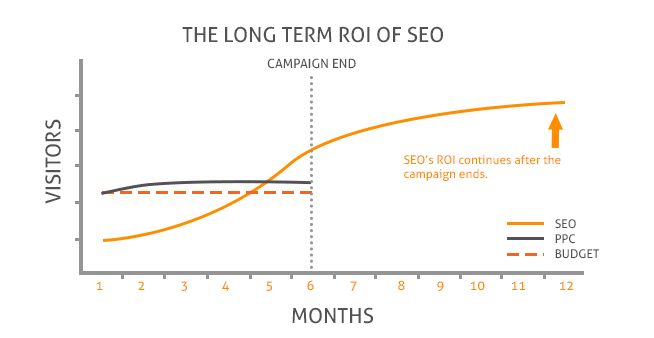
In the end, when you create precise and realistic SEO goals for your website, it ensures that you are moving in the right direction. They can also help you with prioritizing different types of strategies and content that can immensely help the business to grow. Make sure not to outrage while setting such goals that don’t make any difference at all. Think smartly about every action you create and implement, as it is going to reflect in the future results.
Conclusion
Ultimately, SEO is an indispensable part of the digital marketing strategy. While you can find plenty of suggestions online, still making these mistakes is quite common. But now that you are aware of the biggest SEO mistakes try to put conscious efforts to avoid them.
And, if you are using other digital marketing channels, then don’t forget to check out the most common digital marketing mistakes here.
What are the common SEO mistakes that you suggest to avoid? Feel free to share it in the comments section.
